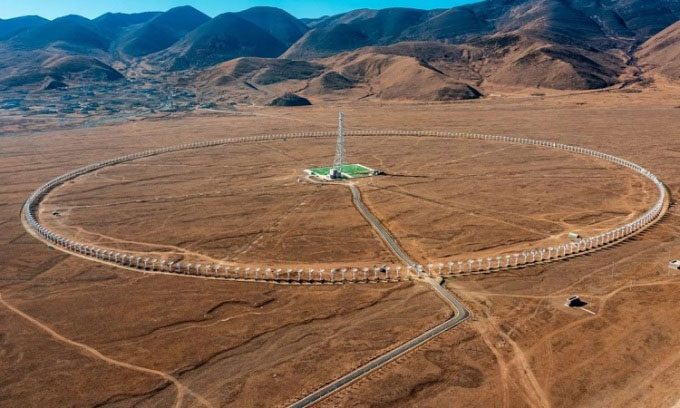The radio telescope array consisting of 313 antennas promises to be a powerful tool for researchers to explore the mysteries of the Sun.
On the edge of the Tibetan Plateau, engineers have completed the installation of the final hardware components for the world’s largest solar research telescope array. The construction of the Dao Cheng Solar Radio Telescope (DSRT), which includes over 300 dish antennas arranged in a circular formation with a circumference of more than 3 kilometers, was completed on November 13. Testing operations are set to begin in June next year. This $14 million observatory will aid researchers in understanding solar eruptions and their impacts on Earth.

The Dao Cheng Solar Radio Telescope (DSRT) is an array of antennas arranged in a circular formation. (Photo: VCG).
According to Maria Kazachenko, a solar physicist at the University of Colorado, Boulder, humanity is entering a golden age of astronomy with many solar telescopes, including NASA’s Parker Solar Probe launched in 2018 and the European Space Agency’s Solar Orbiter launched in 2020. Both spacecraft are collecting data while orbiting the star.
The Sun is preparing to enter a phase of increased activity in the coming years. The radio frequency data collected by DSRT will complement data from telescopes operating at different frequency bands. Over the past two years, China has launched at least four solar observation satellites, including a high-altitude solar observatory that specializes in studying the star in ultraviolet and X-ray frequencies. “China now has the equipment to observe every region of the Sun, from its surface to the outer atmosphere,” said Hui Tian, a physicist at Peking University.
Chinese observatories will also provide crucial data about solar activity that cannot be observed by telescopes in other time zones, according to Ding Mingde, a physicist at Nanning University. Studying the Sun requires global cooperation.
Radio telescopes like DSRT are extremely useful for studying the solar corona, such as solar flares and coronal mass ejections (CMEs). These are massive bursts of hot plasma from the corona, occurring when the Sun’s twisted magnetic fields collide and reconnect. When high-energy particles released by a CME head towards Earth, the result can be space weather that disrupts satellites in orbit and causes power grid outages on Earth. In February, a CME destroyed 40 Starlink communication satellites from the aerospace company SpaceX in California.
DSRT has a wide field of view, at least 36 times larger than the solar disk, allowing the telescope to track the development of CMEs and how high-energy particles travel through space, according to Jingye Yan, chief engineer of DSRT at the National Science Center of the Chinese Academy of Sciences in Beijing. With this information, researchers can predict whether a CME will head towards Earth and when it might occur. The 313 antennas of DSRT enable the telescope to achieve the height necessary for predicting space weather. This large telescope array can detect weak signals from high-energy particles at frequencies ranging from 150 megahertz to 450 megahertz.





















































